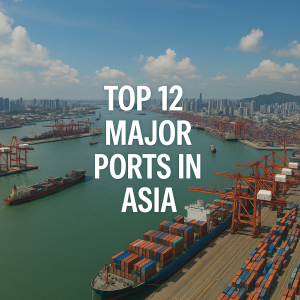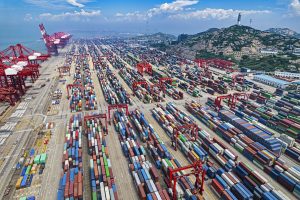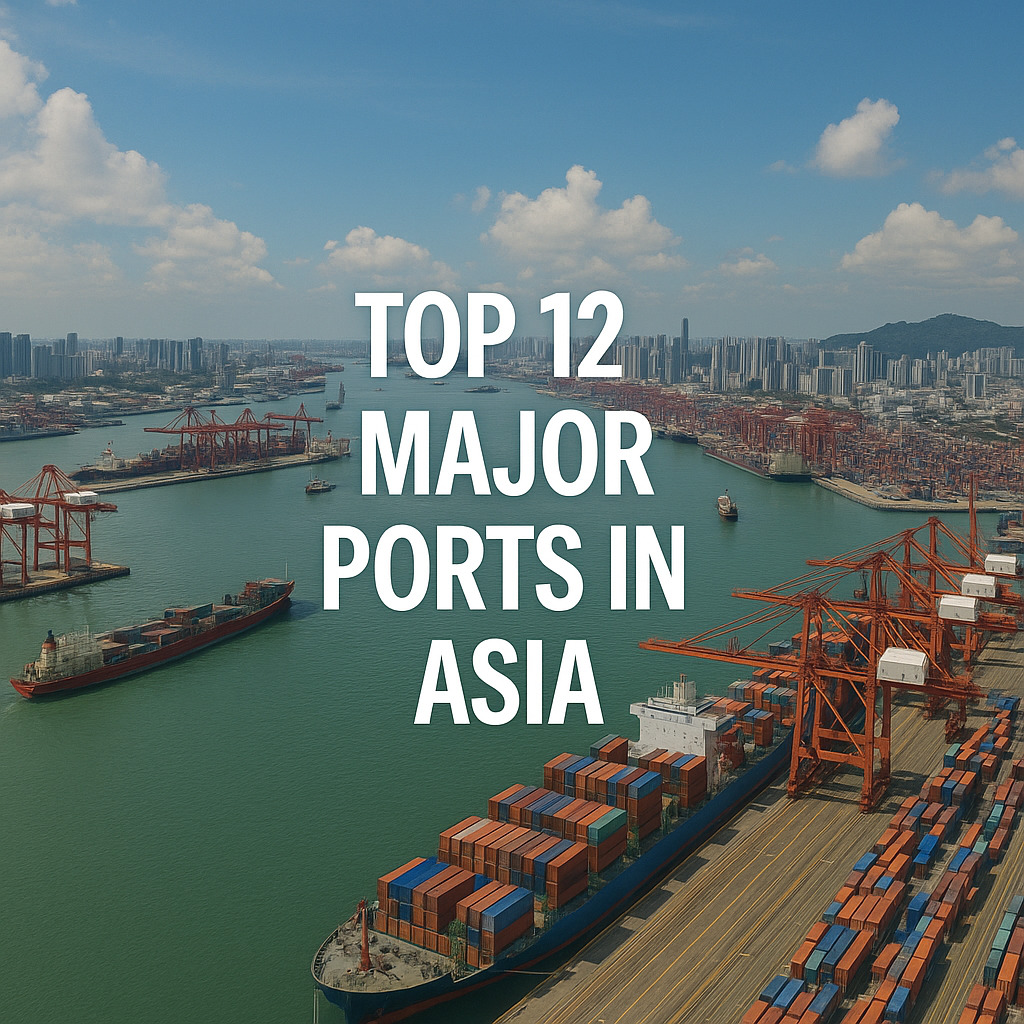Explore the top 12 major ports in Asia, their global trade significance, advanced infrastructure, and evolving role in sustainable maritime logistics. A must-read for maritime professionals and students.

Why Asia’s Ports Matter in Modern Maritime Operations
Asia stands at the heart of the global maritime economy. With over 60% of global container throughput occurring in Asian ports and the continent being home to the majority of the world’s largest cargo-handling hubs, understanding the dynamics of these ports is essential for anyone engaged in international shipping, logistics, or maritime policy.
Driven by explosive economic growth, digital innovation, and geographic advantage, Asia’s ports are not just transit points—they are logistics ecosystems. They enable seamless intermodal connectivity, support mega-vessels with over 24,000 TEU capacity, and increasingly serve as pioneers in green shipping initiatives, complying with the IMO 2023 Carbon Intensity Indicator (CII) regulations and EEXI standards.
This article highlights the 12 most significant ports across Asia, based on container throughput, strategic importance, and technological advancement, drawing on sources like Lloyd’s List Intelligence, UNCTAD, and IAPH.
1. Port of Shanghai (China)
Annual Throughput (2023): 47.3 million TEUs
As the world’s busiest container port, Shanghai’s Yangshan Deep-Water Terminal is a feat of modern engineering. Built on reclaimed islands and linked via the Donghai Bridge, this port is central to China’s Belt and Road Initiative and East Asian manufacturing exports.
Highlights:
-
Fully automated container yard
-
IMO-compliant LNG bunkering
-
Smart Port systems using AI and IoT
Website: portshanghai.com.cn
2. Port of Singapore (Singapore)
Annual Throughput (2023): 37.5 million TEUs
Singapore’s Tuas Mega Port is set to be the world’s largest automated container terminal upon full completion in the 2040s. Already a model of smart logistics, Singapore integrates AI, blockchain, and 5G to orchestrate seamless port operations.
Strategic Role:
Key transshipment hub linking East Asia, Europe, and Africa
Website: mpa.gov.sg
3. Port of Ningbo-Zhoushan (China)
Annual Throughput (2023): 35.3 million TEUs
Total Cargo (2023): Over 1.2 billion metric tons
Known for both bulk and container handling, Ningbo-Zhoushan ranks first globally in overall tonnage. It serves key industrial provinces and hosts ultra-deep berths (up to 24 meters), ideal for ultra-large container vessels (ULCVs).
Website: portnb.com
4. Port of Shenzhen (China)
Annual Throughput (2023): 30.6 million TEUs
This port complex includes Yantian, Chiwan, and Shekou terminals. Shenzhen’s dominance stems from its adjacency to China’s tech and electronics manufacturing hubs.
Technological Integration:
Uses blockchain for customs and Inmarsat systems for fleet monitoring
Website: portsz.com
5. Port of Busan (South Korea)
Annual Throughput (2023): 23.7 million TEUs
Korea’s largest port combines heavy automation with strategic location. It connects East Asia to the Americas and Europe, and its smart port upgrades are developed in collaboration with Korea Maritime & Ocean University.
Innovation Note:
Pilot programs on AI-based cargo stacking and autonomous trucking
Website: busanpa.com
6. Port of Hong Kong (SAR, China)
Annual Throughput (2023): 16.7 million TEUs
Once Asia’s maritime titan, Hong Kong still retains importance for its transshipment capabilities and business-friendly environment. However, competition from neighboring Shenzhen has led to declining volumes in recent years.
Historical Significance:
Formerly the world’s busiest port through the 1990s
Website: hkmpb.gov.hk
7. Port of Guangzhou (China)
Annual Throughput (2023): 25.6 million TEUs
Guangzhou supports South China’s industrial clusters and is a vital node in the Pearl River Delta. Its growth reflects China’s domestic consumption boom and export resilience.
Sustainability:
Investments in electric cargo handling and eco-dredging
Website: portgz.com
8. Port of Qingdao (China)
Annual Throughput (2023): 23.4 million TEUs
Qingdao’s automation is world-renowned. The port operates fully automated terminals, robotic cranes, and 24/7 unmanned yard operations, setting the global standard for smart shipping logistics.
Milestone:
First port globally to fully automate quay crane and yard crane operations
Website: qdp.cn
9. Port of Tanjung Pelepas (Malaysia)
Annual Throughput (2023): 10.5 million TEUs
This rapidly growing port benefits from deep natural waters and close proximity to Singapore. Operated by MMC and Maersk, it’s a strategic transshipment gateway for Southeast Asia.
Operational Advantage:
Berths up to 18 meters deep
Website: ptp.com.my
10. Port of Colombo (Sri Lanka)
Annual Throughput (2023): 8.1 million TEUs
The Colombo International Container Terminal (CICT), managed by China Merchants Port, makes Colombo the transshipment leader for South Asia. The port connects Indian cargo to global routes via Suez.
Strategic Note:
Key link in China’s Maritime Silk Road
Website: slpa.lk
11. Port of Jebel Ali (UAE)
Annual Throughput (2023): 14.2 million TEUs
Though in the Middle East, Jebel Ali deserves mention for its role in Asia-Europe trade. Operated by DP World, it links East Asian exports with MENA and Africa.
Notable Feature:
Fully integrated logistics zone with customs blockchain
Website: dpworld.com/jebel-ali
12. Port of Laem Chabang (Thailand)
Annual Throughput (2023): 8.8 million TEUs
Thailand’s largest port is undergoing significant upgrades, including automation and LNG-ready infrastructure. It’s central to Thailand’s Eastern Economic Corridor initiative.
Development Plan:
Targets 18 million TEUs by 2030 with smart port tech
Website: laemchabangport.com

–
Case Study: Smart Port Evolution at Qingdao
Qingdao’s automated terminal has reduced container dwell times by over 40%, increased TEU handling per crane-hour, and lowered emissions by integrating Wärtsilä energy-efficient systems. It represents the future of human-machine collaboration in maritime logistics.
FAQ Section
1. What is the busiest port in Asia?
Shanghai is the busiest port in Asia and the world, handling over 47 million TEUs annually.
2. Why are so many top ports located in China?
China’s export-driven economy, government investment, and manufacturing dominance make it a global shipping epicenter.
3. Are Asian ports adopting green technology?
Yes. Ports like Singapore, Busan, and Qingdao lead in electrification, shore power, and decarbonization pilot projects.
4. How do ports like Colombo and Tanjung Pelepas stay competitive?
By focusing on transshipment, strategic location, and efficiency gains through automation and foreign investment.
5. What’s the role of classification societies in port operations?
Organizations like DNV, Lloyd’s Register, and ABS advise on port safety, automation systems, and sustainable infrastructure development.
6. How do these ports link to global trade?
They serve as vital links in Asia-Europe, Trans-Pacific, and intra-Asia shipping lanes, handling goods ranging from electronics to energy.
Conclusion
Asia’s major ports are not only central to the region’s economic rise but are also shaping the future of global shipping. As they embrace digitalization, decarbonization, and supply chain resilience, these ports redefine what it means to be a maritime superpower. For policymakers, logistics professionals, and maritime students alike, these hubs are blueprints of operational excellence and sustainable growth.
Call to Action:
Follow these ports’ development through IMO publications, Lloyd’s List data, or port authority updates. Whether you’re mapping global logistics or building the next generation of port infrastructure, Asia’s maritime giants offer lessons in scalability and innovation.
References
-
UNCTAD Maritime Transport Review 2024. https://unctad.org
-
IMO Port Emissions Toolkit. https://www.imo.org
-
Lloyd’s List Intelligence Port Rankings. https://lloydslist.maritimeintelligence.informa.com
-
Port of Shanghai. http://www.portshanghai.com.cn
-
Maritime and Port Authority of Singapore. https://www.mpa.gov.sg
-
Qingdao Port International. https://www.qdp.cn
-
DP World Jebel Ali. https://www.dpworld.com/jebel-ali

